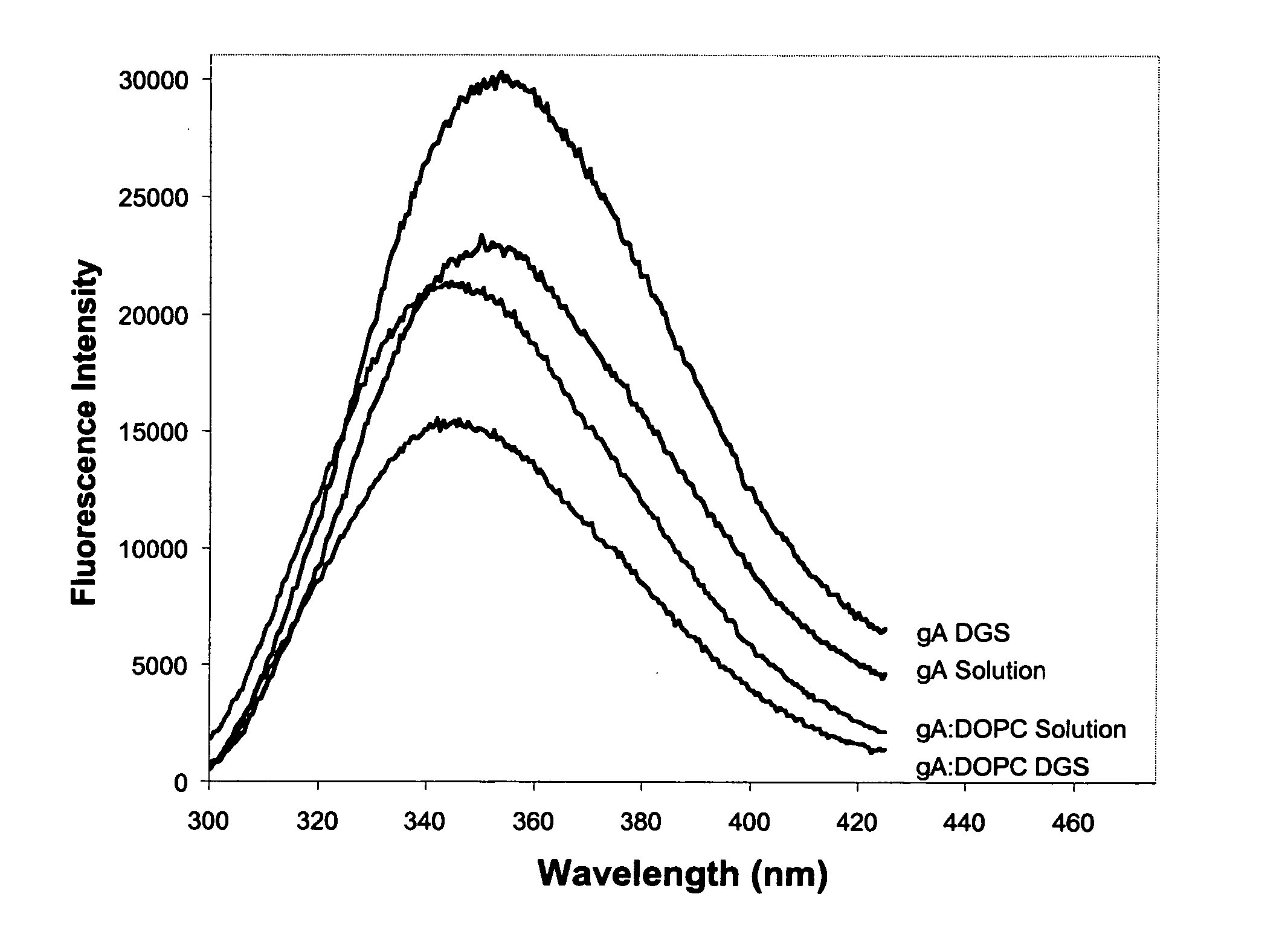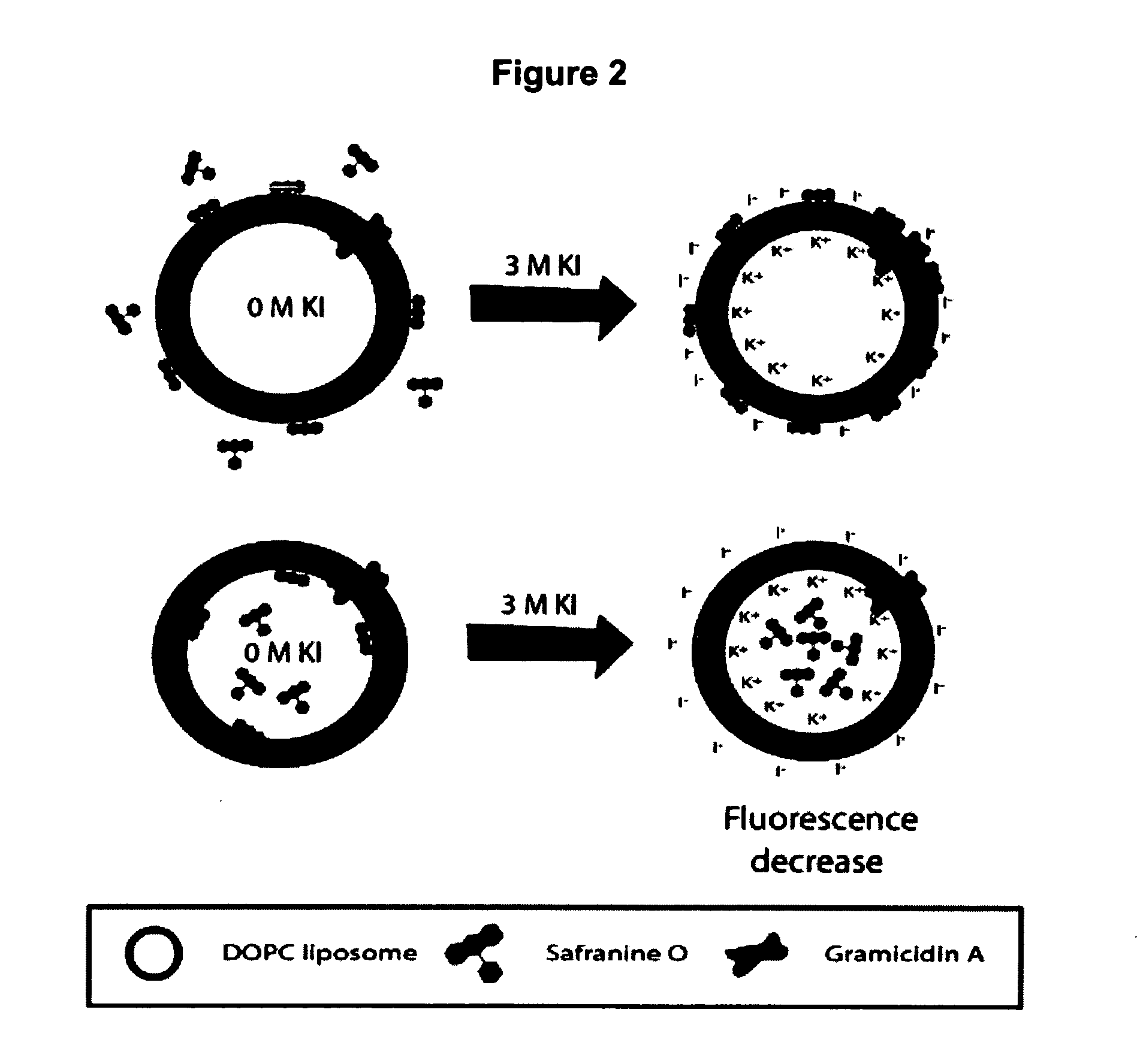Method of immobilizing membrane-associated molecules
a membrane-associated molecule and immobilization technology, applied in the field of membrane-associated molecule immobilization, can solve the problems of limiting the development of new sensors and high-throughput screening technologies that utilize these cellular receptors, and reducing the natural immobilization structur
- Summary
- Abstract
- Description
- Claims
- Application Information
AI Technical Summary
Benefits of technology
Problems solved by technology
Method used
Image
Examples
example 1
Tryptophan Fluorescence of gA
The emission of Trp residues within proteins has been widely used to probe the conformation and dynamics of proteins within sol-gel derived silica.66,67 In the case of gramicidin A, each homodimeric subunit of the ion channel contains four tryptophan residues, which NMR and crystallographic data have shown to be buried within the lipid bilayer.68 Furthermore, the tryptophan residues of gramicidin have been shown to have distinctly different fluorescence emission spectra when located in the bilayer relative to being in solution.54 The fluorescence emission properties of gA can therefore be used to indicate if gramicidin has survived the entrapment process and remained in the bilayer.
FIG. 1 shows the emission spectra of gramicidin A before and after reconstitution into phospholipid vesicles comprised of DOPC, both in solution and after entrapment into DGS derived silicate. The results clearly show that the emission maximum of gramicidin embedded in DOPC...
example 2
Ion Channel Activity of gA
The lipophilic cationic dye safranine O was used to follow the development of an electrochemical potential of K+ across the phospholipid membrane. As shown in FIG. 2, the changes in emission properties depend on whether the probe is located inside or outside of the membrane. As shown in FIG. 2a, upon addition of KCl or KI to a membrane with the probe in the external solution, the influx of potassium ions through gA into the interior of the liposomes, combined with the exclusion of chloride ions, creates an electrochemical gradient across the membrane that is net positive on the interior and net negative on the exterior. Safranine O responds to development of such a membrane potential by partitioning into the hydrophobic lipid core due to the electrostatic attraction of the dye to the net-negative side of the membrane.69,70,71 The net effect is to produce an increase in both fluorescence intensity and anisotropy as K+ enters the membrane, owing to a reduct...
example 3
Inhibitors of gA Ion Channel Activity
A final test of the potential utility of the entrapped gA ion channel was to assess whether the ion channel activity could be inhibited by addition of channel blocking agents. It has been well established that the presence of divalent cations inhibits the flux of potassium and sodium ions through gramicidin by blocking their passage through the channel.76 Inhibition of reconstituted gA entrapped in DGS derived silicate was examined by adding various levels of CaCl2 to the entrapped samples along with 3.0 M KI. As shown in FIG. 6, the presence of calcium ions produces a significant and concentration-dependent decrease in the potential induced fluorescence response to ion flux, consistent with inhibition of the ion-channel activity. The inhibitory effect requires the presence of several hundred millimolar of Ca2+, which in expected given that Ca2+ must compete with molar levels of K+ for access to the ion channel. A benefit of the “inverted” Safr...
PUM
| Property | Measurement | Unit |
|---|---|---|
| v/v | aaaaa | aaaaa |
| molecular weight | aaaaa | aaaaa |
| molecular weight | aaaaa | aaaaa |
Abstract
Description
Claims
Application Information
 Login to View More
Login to View More - R&D
- Intellectual Property
- Life Sciences
- Materials
- Tech Scout
- Unparalleled Data Quality
- Higher Quality Content
- 60% Fewer Hallucinations
Browse by: Latest US Patents, China's latest patents, Technical Efficacy Thesaurus, Application Domain, Technology Topic, Popular Technical Reports.
© 2025 PatSnap. All rights reserved.Legal|Privacy policy|Modern Slavery Act Transparency Statement|Sitemap|About US| Contact US: help@patsnap.com



